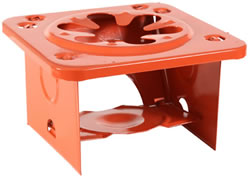Food Prep During Disasters
While we always suggest families have plenty of ready-to-eat food on hand for during extended emergencies, being able to boil water for coffee or heat up a can of soup is also important. Hot food and drink warms the body and the soul. Unfortunately, electricity is usually one of the first things to go during a disaster. While gas stove tops may still work during a crisis, it may not be truly safe to use them either. Plan ahead for these possibilities and figure out how you can cook hot meals for your family when your usual appliances aren't available to you.
How will you cook during a disaster?
One option is to use your outdoor grills. If you have a propane grill, make sure you have at least one full backup tank. Shop around for propane prices too and explore your options. While you can do the tank exchange at the gas station or even Walmart, there are still places around that will just fill your tank for you. In my neck of the woods, I pay around $8.00 to have a tank filled whereas a tank exchange costs around $12.00.
If you have a charcoal grill, stock up on charcoal when you find it on sale, typically just before the summer holidays like Memorial Day and the 4th of July. Keep in mind though that in a pinch you can burn dry wood in a charcoal grill. I was talking to someone who had gone through a major ice storm a few years ago and she said one of the things she learned was to always have an extra bag or two of charcoal as they didn't have any for their grill. I asked why she hadn't just used downed branches and that thought had never even occurred to her.
Are camp stoves the answer?
A gas camp stove is great to have on hand for emergencies as well as when camping. However, be sure you have the small gas tanks for it. Also, these stoves are kind of pricey if the only reason you want one is for your home emergency kit.
 An excellent option for disaster cooking is a folding stove. This is a small unit that uses canned fuel. It is small enough to store very easily and will quickly heat your food and drink. Easy to use, you just fold it open, put the fuel in place and light, then put your pan on top. This type of stove is particularly well suited for those who live in apartments or condos and don't have room for a large grill. It is only a single burner so you may want to invest in a couple of them so you can cook your food and heat your coffee at the same time. This particular unit is very solid with a wide base. One great aspect of using canned fuel is you can control the heat a bit. Use the lid of the can to partially obstruct the hole to lessen the flame.
An excellent option for disaster cooking is a folding stove. This is a small unit that uses canned fuel. It is small enough to store very easily and will quickly heat your food and drink. Easy to use, you just fold it open, put the fuel in place and light, then put your pan on top. This type of stove is particularly well suited for those who live in apartments or condos and don't have room for a large grill. It is only a single burner so you may want to invest in a couple of them so you can cook your food and heat your coffee at the same time. This particular unit is very solid with a wide base. One great aspect of using canned fuel is you can control the heat a bit. Use the lid of the can to partially obstruct the hole to lessen the flame.
The pocket stove is very similar to the folding stove but uses fuel cubes instead of canned fuel. It is very small and light, easily carried in a backpack or duffel bag. The cubes will burn for about 15 minutes each, which is usually plenty of time to heat water for coffee or to heat up a can of pasta. Again though, this is a single burner type of device and if you want to heat more than one thing at a time, you'll need more than one unit.
If you are more of the DIY type, you can build a hobo stove. Take a metal coffee can and drill a series of holes around the can, a few inches from the top. The holes should be about a 1/4" or so. Cut the bottom off the can so you have just a metal cylinder. Then, use tin snips to cut a small door at the bottom of the can, a couple inches high and about three inches across. Leave the metal flap in place so you can bend it up and down.
Build a small fire inside the can and use that small door in the side to add fuel as needed. Place your pan on top of the can to cook. These work very well but you might consider using the canned fuel instead of building a stick fire.
An alternative to canned fuel is to make a buddy burner. This is made using a clean tuna can, cardboard, and melted wax. Cut corrugated cardboard into strips just wide enough to sit sideways in the can without coming over the top. Roll the cardboard around the inside of the can, starting from the middle and working your way to the outer edges. This might take a bit more cardboard than you'd think. Once it is full, melt your wax and pour it into the can, filling all those little holes you see in the edges of the cardboard. You might consider adding a couple pieces of string or old candle wicks at this point too. Once the wax is cool and hardened, simply light it with a match to make a burner. These buddy burners work very well in hobo stoves as well as either of the folding stoves mentioned earlier.
One thing to remember is that no matter which of these methods you use, your normal pans might end up with some blackening on the bottoms. This is because natural gas burns a lot cleaner than these other heat sources. You might consider picking up a couple of camp mess kits to store with your folding or pocket stoves to avoid damaging your good cookware.
